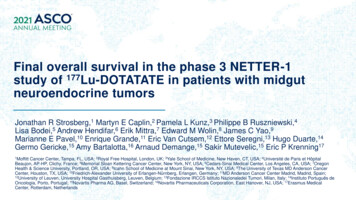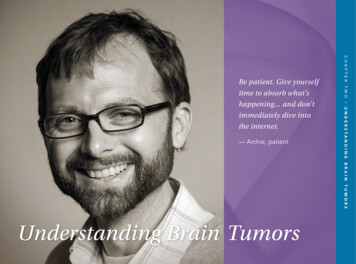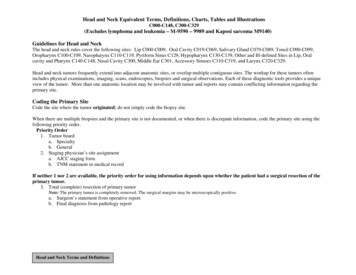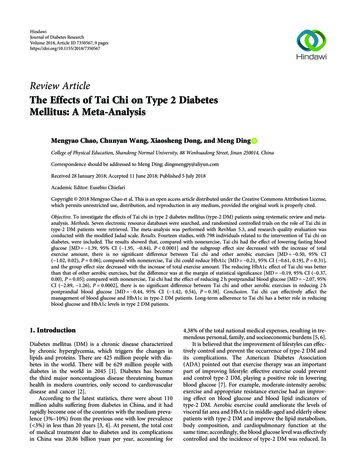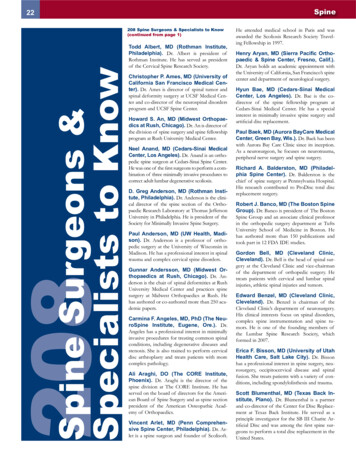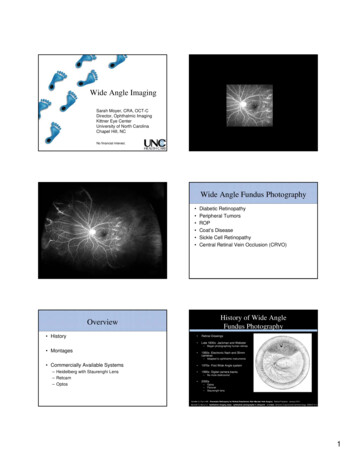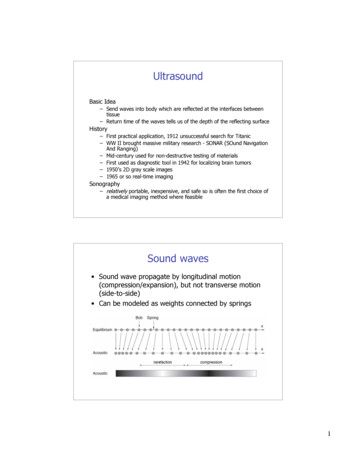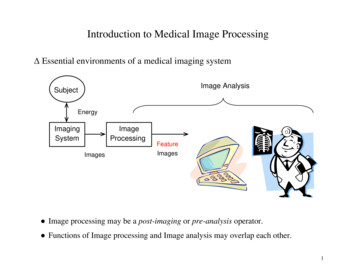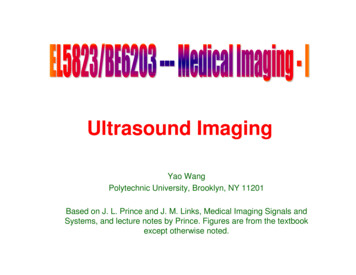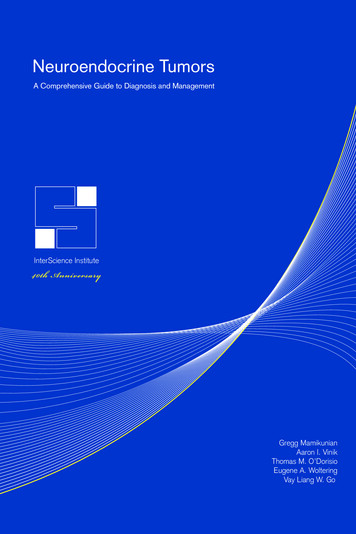
Transcription
Neuroendocrine TumorsA Comprehensive Guide to Diagnosis and ManagementInterScience InstituteInterScience InstituteGregg MamikunianAaron I. VinikThomas M. O’DorisioEugene A. WolteringVay Liang W. Go
Inter Science InstituteAccreditations, Certifications, Licensers and RegistriesCLIA #05D0549406Centers for Medicare and Medicaid (CMS)U.S. Department of Health and Human Services (DHHS)The College of American Pathologists (CAP) #2258701State LicensesState of CaliforniaClinical License Number CLF 1801Radioactive Materials License Numbers 1972-19, 3398-19State of Florida Agency for Health Care AdministrationLicense Number L800013770Maryland Department of Health and Mental HygieneMedical Laboratory Permit Number 862Pennsylvania Department of HealthLab ID Number 026479Rhode Island Department of HealthLicense Number 288U.S. Federal LicensesSocial Security Administration (SSA)Medicare Provider Number 05L0008967Medi-Cal Provider Number ZZZ49545ZFood and Drug Administration (FDA)Registration Number 2050103Nuclear Regulatory Commission (NRC)License Number 04-17814-01EDepartment of Justice (DEA)Registration Number RI0119722Copyright 2009 Inter Science InstituteInter Science Institute944 W. Hyde Park BoulevardInglewood, CA 90302(800) 255-2873(310) 677-3322Fax: (310) 677-2846www.interscienceinstitute.comemail: intersci@earthlink.netFormat, text, and presentation of this publication may not be reproduced forcommercial purposes without written permission of Inter Science Institute.Cover design: Tullula G. Mamikunian
NeuroendocrinETumorSA Comprehensive Guide toDiagnosis and ManagementFourth EditionGregg MamikunianAaron I. VinikThomas M. O’DorisioEugene A. WolteringVay Liang W. Go
Inter Science InstituteGI CouncilChairmanEugene A. Woltering, MD, FACSThe James D. Rives Professor of Surgery and NeurosciencesChief of the Sections of Surgical Endocrinology and OncologyDirector of Surgery ResearchThe Louisiana State University Health Sciences CenterNew Orleans, LouisianaExecutive MembersAaron I. Vinik, MD, PhD, FCP, MACPProfessor of Medicine, Pathology and NeurobiologyDirector of Strelitz Diabetes Research InstituteEastern Virginia Medical SchoolNorfolk, VirginiaVay Liang W. (Bill) Go, MDProfessor of MedicineDavid Geffen School of Medicine at UCLAUniversity of California at Los AngelesLos Angeles, CaliforniaThomas M. O’Dorisio, MDProfessor of MedicineDirector of Neuroendocrine Tumor ProgramClinical Attending, Holden Comprehensive Cancer CenterUniversity of Iowa College of MedicineIowa City, IowaGregg Mamikunian, MSChief Executive OfficerInter Science Instituteii
PrefaceAccretion“ . . . the wisdom that accrues with age . . .”It is a fitting tribute that the 4th edition of the Neuroendocrine Tumors handbook falls onthe 40th anniversary of Inter Science Institute (ISI).The publication arising since the third edition is testimony to the progress of the scienceof Neuroendocrinology in the treatment of carcinoid tumors specifically andneuroendocrine sciences in general. The accretion of knowledge and its particularapplications of these accreted test procedures have placed ISI at the forefront ofproviding the highly specialized tests and assays for usage by the medical establishment.This has been the simple mantra of ISI since its inception, “stay small but perform withdistinction”. The accretion of leadership, performance, experience, commitment, andthe delivery of accurate dependable analytical data, that correlates with the clinicalmanifestation, is the ultimate hallmark of ISI’s capabilities.Thus, we have arrived at this fortieth juxtaposition with a certain degree of pride and agreater degree of satisfaction. Clinical laboratory discipline is a dynamic science, and itmust be nurtured by accruing talented scientists in the specific disciplines it serves.Consequently my high esteem is owed to the GI Council members who have providedISI the catalyst to distinction in recommending test procedures that are novel andclinically significant.Thus a debt of gratitude is owed to the Council members, who are embarking on theirsecond five-year terms, and have served tirelessly resulting in the authorship of the 3rdand 4th editions of the Neuroendocrine Tumors handbooks.Finally I can assure the Carcinoid community—patients, their physicians, clinicians andsupport groups—that ISI’s commitment, dedication, and support will not take recess aslong as I am at the helm.Gregg MamikunianInter Science Institute 2009iii
Acknowledgments to theFourth EditionThe authors of the 4th edition of the Neuroendocrine Tumors handbook sincerelyappreciate the contribution of M. Sue O’Dorisio, MD, PhD for the second chapter of thehandbook. It is a great honor and privilege to have professor Sue O’Dorisio’s hithertounpublished chapter appear in the ISI Neuroendocrine book.The GI Council welcomes professor Joy Ardill, MD, of Royal Victoria Hospital of NorthernIreland, (UK), for her scientific collaborative association with Inter Science Institute.The Council acknowledges Donald W. Richardson, MD of Eastern Virginia MedicalSchool (EVMS) for his contribution on sections of pituitary tumors, Cushings anddiabetes insipidus.Our thanks to Debbie Godsey for updating the ICD-9 codes throughout the chapters ofthe 3rd and 4th editions. Also, our thanks to Etta Vinik for her work on certain sections ofthe handbook.A special thanks to Mia Tepper for the months of diligent attention to details inreviewing the manuscript.The executive members of the council gratefully acknowledges the dedication,foresight and leadership of its chairman Eugene A. Woltering, MD.The enormous contributions of Arthur A. Vinik, MD, Thomas M. O’Dorisio, MD, and VayLiang W. (Bill) Go, MD, encompassing the scientific matrix and its accretion into aclinically useful and diagnostically relevant format must be applauded.Gregg MamikunianInter Science Institute 2009iv
Acknowledgments to theThird EditionThe GI Council of Inter Science Institute presents this comprehensive guide todiagnosis and management of neuroendocrine tumors to provide information andinspiration to all levels of clinicians, from novices to those professionally engaged inthe field of neuroendocrine research, treatment, and analyses. This guidebook addsthe new dimension of patient monitoring, not only through powerfully discriminatingassays but through the recognition of clinical presentations and syndromes. Thisexpertise is made possible by more than 150 years of cumulative experience of theadvisory council.Since the publication of the first GI Handbook in 1977 up to the current edition ofNeuroendocrine Tumors, Inter Science Institute has been at the forefront of bridgingthe gap between academic medicine and the availability of the most current tests forpatient diagnosis. In the intervening three and a half decades, unparalleled progresshas been made both in the diagnosis and treatment of gastrointestinal, pancreatic,and neuroendocrine tumors.This book is meant to be a beacon not only for listing tests but for all aspects ofneuroendocrine tumors. Its publication represents a move from static text to themodern era of communication which allows for dynamic, continuously updating linksto the ISI website, interscienceinstitute.com, as well as endotext.com as referencesources. Additionally, the book combines several references from the previous editionwith an updated bibliography, in recognition of past contributions to the present.Special thanks to our dedicated reviewers of this publication, Etta J. Vinik andMia S. Tepper.Finally, my appreciation and thanks to professors Vinik, Woltering, O’Dorisio, and Gofor imparting their knowledge to the synergistic confluence that has given birth to thisunique edition. Thank you, Arthur, Gene, O’Do, and Bill.Gregg MamikunianInter Science Institute 2006Reprinted from Inter Science Institute’s Neuroendocrine Tumors: A Comprehensive Guideto Diagnosis and Management handbook 2006.v
Acknowledgments to theSecond EditionThe current 1997 edition of the GI, Pancreatic Hormones, Related Peptides andCompounds handbook presents comprehensive information for many rare proceduresand tests that have been requested in the course of the past twenty-eight years.The handbook reflects the tremendous advances that have been made since 1977.The number of tests offered has increased six-fold in addition to increasing specificity,sensitivity of antibodies, and purity of the standards. The protocols dealing withchallenges and provocative testing has been expanded with the latest information.The section on the physiology of the GI and Pancreatic Hormones has been updatedas an adjunct to the various procedures in the handbook.Furthermore, the handbook covers a vast area of gastrointestinal, pancreatic, andother related procedures. Many of these procedures are clearly out of the realm ofroutine testing and request. On the other hand, quite a number of the proceduresare indicators in the clinical confirmation of certain syndromes and disease states.Inter Science has witnessed the phenomenon over the years of the transformationof research-oriented procedures becoming useful, routine, and critical determiningfactors in the diagnosis and management of certain GI-related endocrinopathies.A special acknowledgment to Alan C. Kacena for his dedication and service oftwenty-five years at Inter Science Institute and in bringing the current edition of theGI Hormones handbook into reality.Gregg MamikunianInter Science Institute 1997Reprinted from Inter Science Institute’s GI, Pancreatic Hormones, Related Peptidesand Compounds handbook, 1997.vi
Acknowledgments to theFirst EditionThe great majority of the gastrointestinal and pancreatic peptide hormones andpolypeptide assays listed in this handbook would not have been even remotelypossible had it not been for the tremendous generosity and cooperation of allthe individuals listed below. Without their assistance, the establishment of the GIHormones Laboratory at Inter Science Institute would not have been a reality.Inter Science Institute gratefully acknowledges and thanks Professor V. Mutt ofGI Hormones Laboratory of Karolinska Institute (Sweden) for his immense assistanceand encouragement; Professor N. Yanaihara (Japan); Dr I.M. Samloff (USA); ProfessorJ.C. Brown (Canada); Dr R. Geiger (Germany); Dr R.E. Chance (USA); ProfessorA.G.E. Pearse (England); Dr J.E. Hall (England); Dr R.I. Harvey (England) and ProfessorM. Bodanszky (USA).Our sincerest appreciation to Professor John H. Walsh of the University of Californiaat Los Angeles for his collaboration over the many years and his review and manysuggestions regarding this presentation.Finally, a special acknowledgment to Dr Herbert Gottfried of Inter Science Institute forhis long and dedicated years in bringing the GI Hormones Laboratory into fruition.Gregg MamikunianInter Science Institute 1997Reprinted from Inter Science Institute’s GI & Pancreatic Hormones and Polypeptides handbook, 1977.vii
How to Use This BookThis book is designed for the medical practitioner; it is an educational tool as well as apractical manual for the diagnosis of patients with suspected neuroendocrine tumorsand a variety of associated gastrointestinal disorders, guiding the physician to long-termfollow-up. Conceptually, this text is more than a list of laboratory tests. It comprisestwo informational sections on gastroenteropancreatic tumors and clinical syndromes,both of which provide a step-by-step approach to possible diagnoses. Each diagnosis(with its CPT code provided) relates to appropriate tests in one of the three test sections:assays, profiles, and dynamic challenge tests. The assays are alphabetically arranged.Terminology and test names are cross-referenced in the comprehensive index.Chapter 1”Diagnosing and Treating Gastroenteropancreatic Tumors” describes the complexity of the problemsinvolved with suspected neuroendocrine tumors. It then simplifies the problems by breaking them downunder headings such as ”Distinguishing Signs and Symptoms,” “Diagnosis,” “Biochemical Studies,” and“Hormones and Peptides.” Thus the physician is guided through a decision-making process from diagnosisto follow-up.Chapter 2“Neuroendocrine Tumors in Children and Young Adults“ by Sue O’Dorisio, MD.Chapter 3“Clinical Syndromes” describes the signs, symptoms, and syndromes associated with excessive peptideamine release.Chapter 4“Assays” lists single tests alphabetically. The tests available from ISI are set out with clear and conciserequirements. These include patient preparation, specimen collection, important precautions, shippinginstructions, and CPT codes for insurance purposes.Chapter 5“Profiles” presents a collection of assays that should provide guidance to the diagnosing physician. Someof these tests are available locally, whereas others are available through ISI. This section also includes therequirements given in Chapter 4: patient preparation, specimen collection, important precautions, shippinginstructions, and CPT codes for insurance purposes.Chapter 6“Dynamic Challenge Protocols” describes provocation tests. The drug doses outlined in these tests arerecommendations only and should be reviewed and approved by the attending physician on a patientby-patient basis. Dynamic challenge protocols can be dangerous and should be performed only under thedirect and constant supervision of trained medical personnel who are familiar with expected and potentiallyunexpected responses to provocative testing.viii
Table of ContentsChapter 1Diagnosing and Treating GastroenteropancreaticTumors, Including ICD-9 Codes. 1Gastroenteropancreatic Tumors.3Carcinoid Tumors and the Carcinoid Syndrome .9Gastrinoma (Zollinger-Elliso Syndrom) . 19Insulinomas . 24Glucagonoma Syndrome . 27Somatostatinoma . 30PPoma . 36Ghrelinoma . 38Multiple Endocrine Neoplasia Syndromes . 41Algorithm for the Evaluation and Management ofNeuroendocrine Tumors . 43Chapter 2Neuroendocrine Tumors in Children and Young Adults . 47NETs in Kids. 49Carcinoid . 49Neuroblastoma . 51Gastrinoma . 51Insulinoma/Neisidioblastosis . 51Multiple Endocrine Neoplasia. 52Pheochromocytoma. 52Paraganglioma . 52Munchausen’s Syndrome by Proxy . 52Chapter 3Clinical Presentations and Their Syndromes,Including ICD-9 Codes . 55Flushing . 57Diarrhea . 60Bronchoconstriction (Wheezing) . 62Dyspepsia, Peptic Ulcer . 63Hypoglycemia. 65Dermopathy . 68Dumping Syndrome . 69Pituitary and Hypothalamic Disorders. 71Hyperprolactinemia. 72Acromegaly and Gigantism . 73Cushing’s Syndrome . 76Other Pituitary Hypersecretion Syndromes. 80ix
Table of ContentsPituitary Hormone Insufficiency (Childhood) . 83Diabetes Insipidus (Adulthood) . 84Hyponatremia and Syndrome of InappropriateAntidiuretic Hormone . 87Chapter 4Assays, Including CPT Codes . 91Introduction . 93Adiponectin . 96Amylin . 97Bombesin . 98Brain Natriuretic Peptide (BNP) . 99C-Peptide .100C-Reactive Protein (CRP; Highly Sensitive for Metabolic Syndrome) .101C-Reactive Protein (CRP; Regular for Inflammation).102Calcitonin (Thyrocalcitonin) .103Carboxy Methyl Lysine (CML).104Cholecystokinin (CCK) .105Chromogranin A (CgA) .106Elastase, Pancreatic, Serum.107Elastase-1 (EL1), Fecal .108Exendin .109Fibrinogen.110Galanin .111Gastric Inhibitory Polypeptide (GIP; Glucose-DependentInsulinotropic Peptide) .112Gastrin .113Gastrin-Releasing Peptide (GRP) .114Ghrelin .115Glucagon .116Glucagon-Like Peptide 1 (GLP-1) .117Growth Hormone (GH, Somatotropin) .118Growth Hormone–Releasing Hormone (GH-RH) .119Histamine .120Homocysteine.121Insulin .122Insulin, “Free” .123Insulin Antibodies .124Insulin—Proinsulin .125Lanreotide (Somatuline Depot) .126Leptin .127Motilin .128Neurokinin A (NKA; Substance K) .129x
Table of ContentsChapter 4 (cont.)Neuropeptide Y (NPY).130Neurotensin .131Nuclear Factor Kappa B (NFκB) .132Octreotide (Sandostatin ) .133Pancreastatin .134Pancreatic Polypeptide (PP) .135Pepsinogen I (PG-I) .136Pepsinogen II (PG-II) .137Peptide Histidine Isoleucine (PHIM) .138Peptide YY (PYY) .139Plasminogen Activator Inhibitor 1 (PAI-1) .140Prostaglandin D2 (PGD2) .141Prostaglandin D2 (PGD2), Urine .142Prostaglandin E1 (PGE1) .143Prostaglandin E2 (PGE2) .144Prostaglandin E2, Dihydroketo (DHK-PGE2) .145Prostaglandin F1α (6-Keto (6-Keto PGF1α)Prostaglandin I2 (PGI2) Metabolite.146Prostaglandin F1α, 6-Keto (6-Keto PGF1α), PGI2 Metabolite, Urine .147Prostaglandin F2α (PGF2α) .148Prostaglandin F2α, Dihydroketo (DHK-PGF2α).149Secretin .150Serotonin (5-HT), Serum .151Somatostatin (Somatotropin Release–Inhibiting Factor [SRIF]).152Substance P .153Thromboxane A2 .154Thromboxane B2 .155Thromboxane B2, Urine .156Thyroid-Stimulating Hormone (TSH; Thyrotropin) .157Thyrotropin-Releasing Hormone (TRH) .158Vasoactive Intestinal Polypeptide (VIP) .159Vasoactive Intestinal Polypeptide (VIP), Urine .160Chapter 5Profiles, Including CPT Codes .161Bronchospasm Profile .163Carcinoid Follow-Up Profile.165Diarrhea Syndrome Tests .168Dumping Syndrome .170Flushing Syndrome Tests .172Gastrinoma (Zollinger-Ellison) Screen .175xi
Table of ContentsGeneric Follow-Up Profiles Pancreas and MEN Tests .176Genetic Studies .177GI–Neuroendocrine Tests .178Hypoglycemia/Insulinoma Screening Test .180Interleukins Individually and as a Profile (IL-1 through IL-18).181Lipoprotein Profile (Total Cholesterol, HDL-C, LDL-C, Particle Size,and Triglycerides .182MEN Syndrome Screen .183Chapter 6Dynamic Challenge Protocols, Including CPT Codes .187Rationale for Dynamic Challenge Protocols .188Calcium Stimulation for Gastrinoma .189Insulin Hypoglycemia Provocation of Pancreatic Polypeptideas a Test for Vagal Integrity .190Insulin Hypoglycemia Provocation of Growth Hormone, ACTHand Cortisol (Insulin Tolerance Test) .191Meal (Sham Feeding) Stimulation for Vagal Integrity .193Octreotide Suppression Test for Carcinoid and Islet Cell Tumors .194Oral Glucose Tolerance Test for Diabetes, Insulinoma,Impaired Glucose Tolerance, Metabolic Syndrome, PCOS,Reactive Hypoglycemia, and Acromegaly .196Pentagastrin Stimulation Test for Calcitonin(Medullary Carcinoma of the Thyroid) .199Pituitary and Hypothalamic Disorders Tests .200Provocative Tests for Dumping Syndrome .201Secretin Stimulation Test for Gastrinoma .20272-Hour Supervised Fast for the Diagnosis of Insulinoma .203Water Deprivation/Desmopressin Test for Diabetes Insipidus:Hypothalamic (HDI), Nephrogenic (NDI), and Dipsogenic (DDI) .204Water Load Test for Impaired Water Clearance.206Clinical Presentation of Pheochromocytoma .207Proposed Testing for Pheochromocytomas .210Proposed Testing for Post Gastric Bypass Risk forHypoglycemia and Nesideoblastosis .212Proposed Testing for Bone Metastases .216Index.221Abbreviations .238Sample Requisition Slip .243xii
iii Preface Accretion “ . . . the wisdom that accrues with age . . .” It is a fi tting tribute that the 4th edition of the Neuroendocrine Tumors handbook falls on the 40th anniversary of Inter Science Institute (ISI). The publication arising since the third edition is
